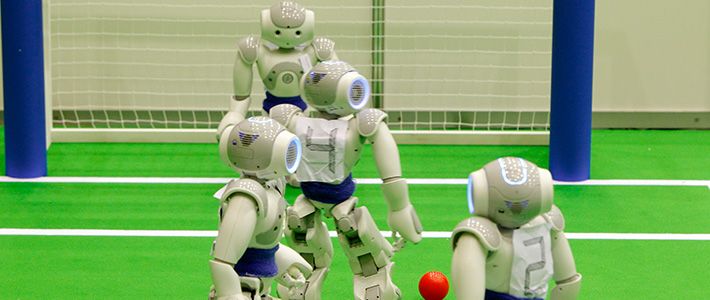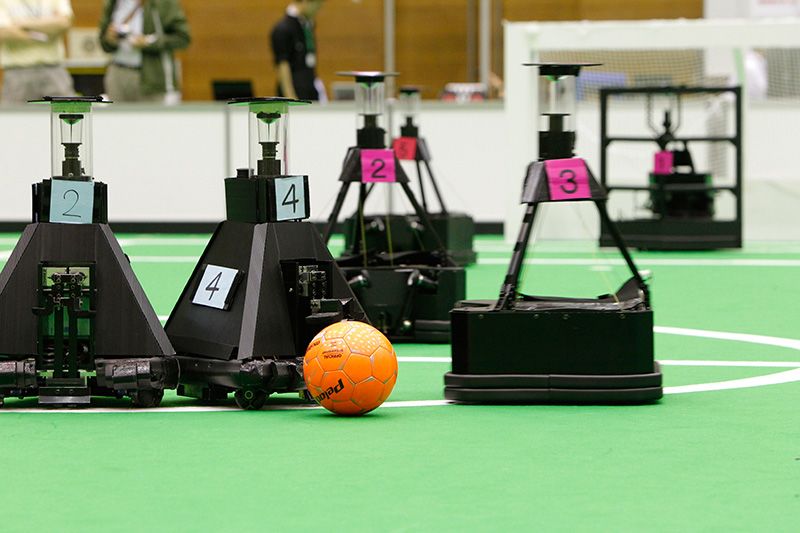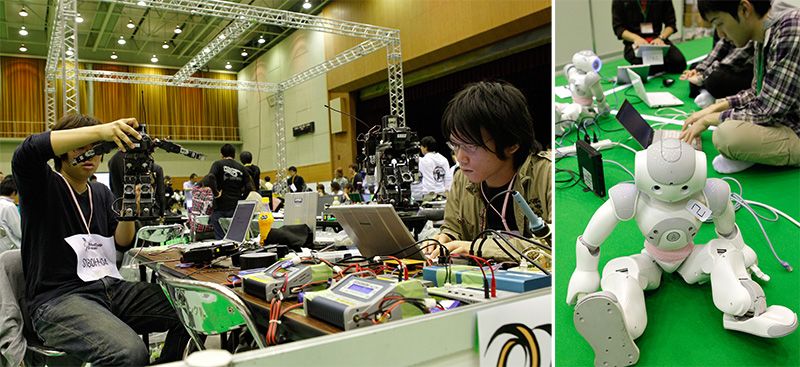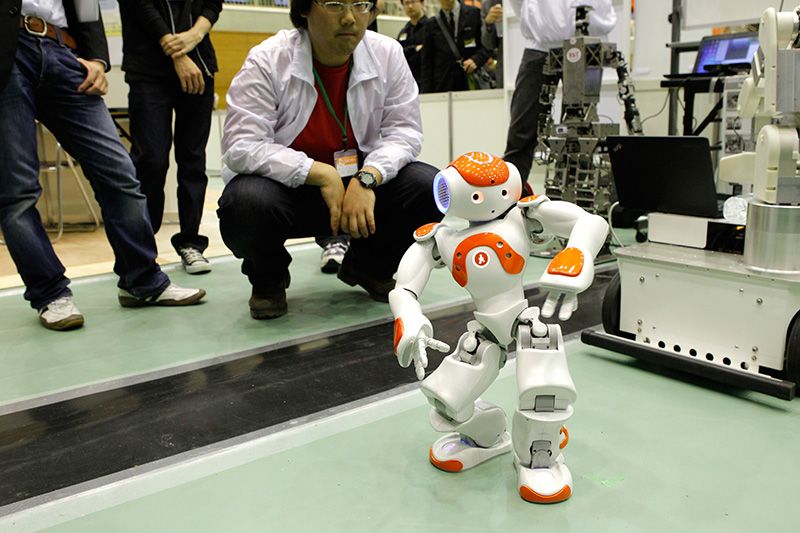
Japan’s Robots: Becoming More Human
Robot Soccer
Science Technology Society Lifestyle- English
- 日本語
- 简体字
- 繁體字
- Français
- Español
- العربية
- Русский
Searching for the Robot Ronaldo
In May, the Osaka Institute of Technology hosted a soccer tournament with a difference. At “RoboCup,” teams of humanoid and non-humanoid robots made in Japan battled each other in one exciting match after another. The Japan Open brought together 73 teams of robotics and AI researchers and their students—456 people in total. At stake was a place at the sixteenth RoboCup world championships, held in Mexico City in June—an annual event that draws teams from over 40 countries around the world.
 Teams of robot soccer players vie for the right to compete at the RoboCup World Championship (left). Young faces fill the crowds. Might these be the robot developers of the future? (right).
Teams of robot soccer players vie for the right to compete at the RoboCup World Championship (left). Young faces fill the crowds. Might these be the robot developers of the future? (right).
Japanese robotics researchers proposed the RoboCup in 1992. The idea was to hold a tournament between fully autonomous humanoid robots. The goal is simple, if ambitious: to create a team of robots that can take on and beat the human World Cup champions by the year 2050. The project has since expanded beyond soccer to encompass three further divisions: “RoboCup Rescue” for emergency assistance robots, “RoboCup@Home” for domestic service robots, and “RoboCup Junior” for competitors under 20 years old.
Full Force: The Middle-Size League
 The larger scale of the Mid-Sized League makes the games an impressive spectacle.
The larger scale of the Mid-Sized League makes the games an impressive spectacle.
Of the four divisions, RoboCup Soccer continues to draw the most participants. The soccer competition is made up of four leagues for autonomous AI robots, and the simulation league, where AI programs compete virtually against each other inside computers.
For pure power, the Middle-Sized Robot League is the league to watch. The games are five-a-side, and played with a regulation-sized football. Each robot is required to fit within a circle 50 centimeters in diameter.
The skill and styles of the teams that take the 18 by 12 meter field vary widely. Some robots malfunction and fail to move as intended, while others manage to string passes together and score goals effectively. Watching these more accomplished robot players, it’s hard to believe that they are not remote-controlled. But no one is piloting these machines. The robots at the RoboCup are totally autonomous. The robots are equipped with cameras and computers that help them to calculate the position of the ball. Based on this information, they can come up with a plan of action and implement it without any further human input.
Speed is the order of the day in the Small-Size League, where the robot players are limited to a height of 15 centimeters and must fit within a circle 18 centimeters in diameter. These robots survey the playing field via individual mounted cameras and a shared camera on a scaffold above the field. The speed and lightness of the robots and the hardness of the golf ball used this league can combine for explosive results. The ball sometimes flies out of the field of play.
 Makers spend months preparing their robots for this major event. The tension shows on the competitors’ faces (left). In the Standard Platform League, every team uses the same model of robot. Success or failure depends on the level of the AI programming (right).
Makers spend months preparing their robots for this major event. The tension shows on the competitors’ faces (left). In the Standard Platform League, every team uses the same model of robot. Success or failure depends on the level of the AI programming (right).
Hope Shines in the Eyes of Young Competitors
The Humanoid League is marked by a different kind of excitement and tension. Here, balance is the key. These two-legged robots have to plant a pivot foot to keep their balance, and then swing the other to kick the ball. Many of the robots wobble precariously as they struggle to pull off this precarious balancing act.
Clearly, the challenges involved in developing robots that can play soccer like humans are huge. Detractors may find the dream of defeating the World Cup champions with a team of robots risible. But for the young designers, many of them in their teens and twenties, the dream is no joke. As one watches them cheer their robots on, the passion and ambition is clear to see. And after all, robots have already overtaken the greatest human masters at chess and shōgi. Maybe it’s not so farfetched to imagine that robots will one day have the world of soccer at their feet as well.
 The NAO humanoid robot, manufactured by Aldebaran Robotics, is the designated robot used by all teams in the Standard Platform League. Here, NAO demonstrates its impressive sense of balance.
The NAO humanoid robot, manufactured by Aldebaran Robotics, is the designated robot used by all teams in the Standard Platform League. Here, NAO demonstrates its impressive sense of balance.
(Originally written in Japanese by Hayashi Aiko. Photographs by Ōkubo Keizō.)
Robots RoboCup RoboCup Soccer Osaka Institute of Technology AI Hayashi Aiko Soccer